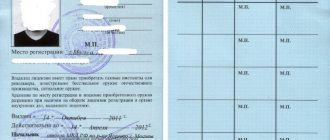What does the “brick” sign prohibit?
First of all, let’s look at the description of sign 3.1 “entry prohibited” from the section prohibiting signs of the traffic rules:
3.1 "No entry". Entry of all vehicles in this direction is prohibited.
This sign prohibits the movement of vehicles in one direction . That is, you cannot enter the selected section of the road only from the side of the “brick” sign.
It is important to understand that movement in the opposite direction is most often permitted. That is, a driver driving under a brick must be prepared for other cars to drive right into his head.
In addition, movement is prohibited for all vehicles, that is, not only cars, but also buses, trucks, motorcycles, mopeds, bicycles, etc.
Procedure for appealing prosecution
A person held accountable may appeal a decision made against him if he believes that the violation committed was not his fault or that the responsibility for the committed act is too severe.
The appeal procedure is presented in Article 30.2 of the Code of Administrative Offenses of the Russian Federation. So, according to this norm, a complaint against a decision is filed with the court or the body that issued it. Then the complaint, together with all the documents collected on the case, is sent to a higher court or a higher official within 3 days.
If the complaint is filed “to the wrong address,” that is, to a judge or official whose consideration is not within his authority, it will be transferred to the proper addressee in accordance with the rules of jurisdiction or jurisdiction. The transfer will be carried out within 3 days.
Experts recommend that when appealing, you immediately go to court, since in this case the case will be examined objectively with the study of all materials available on the case.
If the court requires additional data in addition to what is contained in the materials already submitted, the required examinations will be appointed, witnesses will be interviewed, requests for information will be sent and other actions will be taken to obtain complete, reliable and objective data.
Going to court looks more attractive for the reason that the adversarial aspect of the judicial process remains, i.e. the judicial process is a “swing”, and the applicant may well turn the case in his favor. If we are talking about appealing a decision to a higher official, then there is no element of competition.
The decision of an official, although according to all interpreted rules should be objective, is made only on the basis of real facts with their objective assessment, one way or another, departmental solidarity, and sometimes even personal interest, can still be traced. Therefore, there is no guarantee that the extrajudicial procedure will be completely objective and legal.
Who is allowed to drive under the brick sign?
The section prohibiting signs in 2021 contains the following exception:
The signs do not apply to:
- 3.1 - 3.3, 3.18.1, 3.18.2, 3.19 - for route vehicles;
That is, route vehicles can ignore the requirement of the “entry prohibited” sign and this will not be a violation.
In practice, you can encounter situations where bus and trolleybus routes are laid along streets where entry is prohibited by bricks. Only fixed-route transport is allowed on such streets.
In this case, you need to understand that a bus or trolleybus can only pass under a brick that is located directly on its route. If a bus deviates from the route into some courtyard and tries to pass there under a “no entry” sign, then this will be a violation. This is due to the fact that a bus is a route vehicle only until it moves along its route.
Traffic regulations for route vehicles
Is it possible to avoid punishment?
Why a motorist can challenge his fine:
- The sign was installed without the participation of an inspector, without the knowledge of local administration employees. Representatives of a company put up such a sign, without approval, if they want to prevent other people’s cars (not owned by employees) from entering their territory. If the inspection authorities did not give permission, in this case the driver’s conscience may be clear - he did not violate the rule, but the fine was issued erroneously.
- Legislative standards have not been followed. Wrong height or location. In this situation, the violator can refer to the fact that the sign is completely invisible from a distance. For example, a “brick” is covered with branches of nearby trees. The main argument in favor of the car owner is photographs of the controversial sign.
- If there are signs next to the sign that neutralize its effect. These are plates 8.3.1. – 8.3.3., 8.4.1. – 8.4.8.
- If after one prohibited intersection a motorist enters another. There should once again be a “no entry” sign.
“No entry” or “brick” is a road sign that is one of the most “respected” among drivers. It is a red circle with a white rectangle in the middle. Prohibits passage for cars and trucks, with the exception of route public transport.
Some people confuse it with the “no movement” sign, but these designations are somewhat different and not only in appearance.
The fine for 2021 just for violating the main warning is five hundred rubles, but often one violation leads to many others, because of which you can lose your driver’s license for up to a year.
Didn't find the answer to your question? Find out how to solve exactly your problem - call right now: +7 (Moscow) +7 (812) 309-53-42 (St. Petersburg) It's fast and free!
Free online consultation with a car lawyer
Didn't find the answer to your question? Find out how to solve exactly your problem - call right now: +7 (Moscow) +7 (812) 309-53-42 (St. Petersburg) It's fast and free!
Penalty for driving under a brick onto a regular road?
The peculiarity of the “no entry” sign is that it only tells the driver that the specified section of the road cannot be entered. However, it gives absolutely no information about what exactly awaits the driver at the specified section. In principle, this is quite logical, because a law-abiding driver simply will not drive under a brick.
However, if we consider the situation from the other side, then a driver driving under a brick cannot know in advance what punishment awaits him. It all depends on which road the car ends up on:
- on the regular road
- on a road with a dedicated lane for public transport,
- onto a one-way road.
Let's consider each situation separately.
In this example, the driver drives through a prohibitory sign and ends up on a very ordinary two-way road. That is, in this case, he violates only the requirement of the road sign and can be punished under Part 1 of Article 12.16 of the Administrative Code - a warning or a fine of 500 rubles .
For example, such a fine will be imposed on a driver who drove under a brick into a gas station where there is no one-way traffic.
How can traffic police officers prove the driver’s guilt?
Statistics show that employees most often do not have to prove anything. There are almost always patrols not far from possible places of violation, which can immediately record an offense.
And then they will simply stop the offending driver and find out the reason.
A camera can also record the violation , but there is a possibility that the car will not be identified. The equipment may simply not be able to “see” the license plate number of the violator’s car, thereby preventing him from being able to present anything and punish him.
It happens that traffic police officers try to punish the driver without clarifying all the circumstances. For example, if the driver has every right to enter the territory of an enterprise, entry to which is limited by a brick sign, and he has all the evidence of this fact.
But in such situations, you should not be rude to the police officer, and you should also not give him your driver’s license ahead of time. The situation should be discussed calmly, if possible recording it on camera or a video recorder (the audio recording will not be accepted in court as evidence). Also, the driver can not rush to put his own signature on the protocol, but ask him to send it by mail to his place of residence , and by that time collect the necessary evidence to challenge the punishment. Find out more about in what cases and where you can appeal traffic police fines here, and you can read about how to challenge a fine from video recording cameras in this material.
You may be interested in learning about other traffic offenses and the fines imposed for them: for driving while drunk or without documents, for driving lights or using a non-working tachograph, for hitting an obstacle or a pedestrian, for overtaking or speeding.
Penalty for driving under a brick in a dedicated lane
Consider the following example, when, ignoring the “no entry” sign, the driver ends up in a dedicated lane for public transport:
For driving in the same dedicated lane in 2021, the driver will receive a fine provided for in Part 11 or Part 12 of Article 12.17 of the Administrative Code.
If the violation was committed on the territory of Moscow or St. Petersburg, the fine will be 3,000 rubles . In other regions, the fine is less - 1,500 rubles .
Fine for driving in a dedicated lane
What provisions of the Code of Administrative Offenses can be referred to in a complaint?
This point is also worth paying attention to, because the correct justification of your request for a complaint is the key to a positive outcome in the case in general. It is one thing if the document contains one text, and quite another if it is supported by specific references to the law. But in order to know which points of administrative legislation to specifically refer to, you need to have at least minimal legal knowledge.
To properly substantiate your words, you can make reference to the following articles of the Code of Administrative Offenses of the Russian Federation:
Article 30.1 of the Code of Administrative Offenses of the Russian Federation. You will have to refer to the norm in any case, because it is it that guarantees the right to appeal any administrative decision in principle.
Article 2.9 of the Code of Administrative Offenses of the Russian Federation. The norm gives the right to the judge or official considering the complaint to release the offender from liability, limiting himself to an oral remark. However, in order for this to happen, the act must be minor, i.e., not entail serious consequences.
If, for example, the committed act violated the interests of another person or its commission caused harm of a material or moral nature, it cannot be considered insignificant in any way. In addition, the norm gives the judge or official the right to release the offender from liability, but does not oblige him to do so.
Article 24.5 of the Code of Administrative Offenses of the Russian Federation. The norm names a number of circumstances when a person can be released from liability.
There are several grounds for exemption from prosecution:
- the violation of the law was due to extreme necessity - the violation occurred due to the fact that the driver tried to eliminate any danger to himself and third parties;
- the violation was due to necessary defense - the offender acted in order to protect himself;
- the statute of limitations established by Part 1 of Art. 4.5 Code of Administrative Offenses of the Russian Federation.
This also includes the absence of an offense or an offense in principle, because if a person’s act seemed to be a violation, but in fact it was not, there can be no guilt.
Fine for driving under a brick on one-way traffic
Let's consider another possible option. When driving under a brick sign, the driver ends up on a one-way road, and he is driving along it in the opposite direction:
For driving in the opposite direction, a driver in 2021 may be punished under Part 3 or 31 of Article 12.16 of the Code of Administrative Offences.
For the first violation, the driver will receive a fine of 5,000 rubles or will be deprived of his license for a period of 4 to 6 months.
In case of repeated violation, the driver will be deprived of his license for 1 year . If the violation is recorded by an automatic camera, then instead of deprivation of the driver’s license, he will receive a fine of 5,000 rubles.
Contents of the complaint
The procedure for appealing a decision, regardless of which body the appeal is to, begins with the preparation of an administrative complaint.
Lawyers recommend adhering to a single template, which includes the following information:
- The official name of the judicial body to which the complaint is being sent, or the official position of the superior official to whom the complaint will be submitted for consideration.
- Profile and contact information about the applicant himself - this is his full name, his place of residence, contact telephone number.
- Information about the official with whose actions the applicant disagrees.
- Information about the incident itself (narrative part) - in this part of the complaint, the applicant can rewrite the descriptive part of the appealed decision, but it would be more reasonable to present the circumstances from his point of view. In this part, you also need to use references to the Code of Administrative Offenses of the Russian Federation, and also name the resolution (number and date), which, in fact, is being appealed.
- The applicant’s request (petition part) - here the person’s request to cancel the decision or mitigate the penalty is directly stated.
- Attachments are additional documents attached to the complaint, which, from the point of view of the applicant, can prove his case and the correctness of his position. The list of documents must include a copy of the appealed decision. All other documents are attached by the applicant at his request.
- Date, signature and signature transcript.
Thus, anyone who considers themselves innocent or burdened with liability beyond the prescribed norm can draw up a document to appeal the fact of being held administratively liable for driving under a “brick.”
Filing an administrative complaint is free, since no state duty is charged (Part 5, Article 30.2 of the Code of Administrative Offenses of the Russian Federation). However, in the vast majority of cases, you can file a complaint yourself, without turning to lawyers for help.
Table of fines for driving under a brick
Let's present the fines listed above in table form:
| Entrance under a brick sign | Punishment |
| on a regular road | warning or 500 rubles |
| to a dedicated lane for public transport | 3,000 rubles in Moscow and St. Petersburg 1,500 rubles in other regions |
| onto a one-way road in the opposite direction | 5,000 rubles or imprisonment for a period of 4 to 6 months for the first violation, imprisonment for 1 year or 5,000 rubles for a repeated violation |
Traffic police fine table
Appeal period
It is very important to meet the deadline for appealing the decision, because if it is missed without a good reason, the complaint simply will not be considered. This means that the resolution will remain in force, and the violator will still have to bear responsibility. Therefore, it is important to have time to file a complaint within 10 days, the period of which begins from the moment when the decision was made, or from the moment when it was served on the violator.
A missed deadline can be restored, but to do this you will need to prove that it was missed for a good reason, i.e. you will have to submit documents confirming this fact. In this case, the complaint will have to be accompanied by a petition asking to restore the appeal period, as well as a document confirming a valid reason for missing it. It is also possible to express this request in the text of the complaint itself.
Whether the term will be restored depends on the opinion of the judge or official. Again, it is best to go to court, because then you can really count on an unbiased decision.







